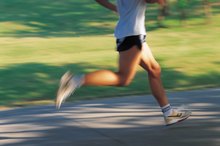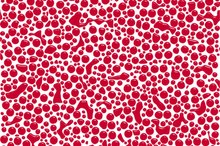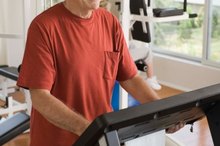More Articles
- Why Must Athletes Exercise Harder & Longer to Achieve a Maximum Heart Rate?
- How Long for Your Blood Pressure to Return to Normal After Running?
- How the Heart & Lungs Work During Exercise
- Why Does Blood Become More Acidic When Carbon Dioxide Increases?
- How Do the Walls of the Atria & Ventricles Differ?
Why Must Athletes Exercise Harder & Longer to Achieve a Maximum Heart Rate?
Athletes can exercise longer and harder than most people, but compared to the average person, it is very challenging for an athlete to work hard enough to achieve his maximal heart rate. This is because of the years of training athletes have put in. The athlete's body has some physiological adaptations that increase his tolerance to intense exercise, thus making it difficult to reach a maximal heart rate.
Stroke Volume
A main change that occurs in athletes is an increase in stroke volume. Stroke volume is the amount of blood that is pumped in each heartbeat. As an athlete trains, stroke volume increases -- the heart becomes more efficient. As a result, the heart does not need to beat as much. This means that during exercise, the athlete's heart is pumping a lot of blood, so it does not need to beat as frequently. In addition, at rest, the athlete's heart pumps less often, meaning the athlete has a lower resting heart rate. This creates a larger gap between resting and maximal heart rate, meaning it will take the athlete longer to reach the maximal heart rate.
AVO2 Difference
Why Must Athletes Exercise Harder & Longer to Achieve a Maximum Heart Rate?
Learn More
AVO2 Difference, or arteriovenous oxygen difference, is the difference in the oxygen content in blood before entering the muscle and after entering the muscle. As an athlete trains, the muscles become more effective at taking oxygen out of the blood. Since heart rate is dependent on the amount of oxygen demanded by muscles, the heart rate will slow as an athlete's AVO2 difference increases. Again, this means that the athlete's body is more efficient. The athlete's heart pumps more blood with an increase in stroke volume, and the muscles are better able to withdraw oxygen from the blood, and both result in a lower heart rate at any given workload.
Lactate Threshold
For any person doing incrementally increasing exercise, there is a point called the lactate threshold. At this point, the body is no longer able to metabolize the acid produced during exercise, and blood lactic acid levels spike, causing an increase in breathing, heart rate and fatigue. For an athlete, the lactate threshold is very high, meaning the athlete will not see the increase in heart rate as early as most people -- he will have to work very hard to reach this point. The athlete has an increased threshold due to a high volume of training at or above the threshold, which improves the body's ability to tolerate the acid, thus increasing the threshold.
VO2max
How Long for Your Blood Pressure to Return to Normal After Running?
Learn More
An athlete also has a higher VO2max, or maximal oxygen uptake. This measures the amount of oxygen a person can take in at maximal exercise -- the more fit you are, the more oxygen your body can take in. VO2max usually occurs at or around maximal heart rate. Because of the improvements in stroke volume, AVO2 difference and lactate threshold, as well as many other factors, an athlete's VO2max is very high. To reach this high VO2max, the athlete must work very hard for a long time -- the body is well suited to work at lower workloads due to all of those adaptations.
Related Articles
References
- Journal of Sports Medicine: Evidence and Possible Mechanisms of Altered Maximum Heart Rate with Endurance Training and Tapering
- Exercise Physiology Theory and Application to Fitness and Performance; Scott K. Powers and Edward T. Howley
- ACSM’s Resource Manual for Guidelines for Exercise Testing and Prescription, 5th edition; Leonard A. Kaminsky
Writer Bio
This article was written by the CareerTrend team, copy edited and fact checked through a multi-point auditing system, in efforts to ensure our readers only receive the best information. To submit your questions or ideas, or to simply learn more about CareerTrend, contact us [here](http://careertrend.com/about-us).








